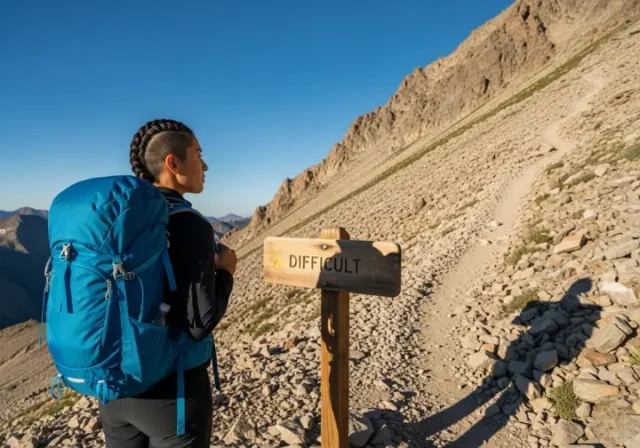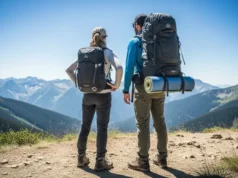In this article
The difference between a great hike and a grueling one often comes down to a single piece of gear: your backpack. A poorly chosen pack can cause fatigue, pain, and unpreparedness, its straps digging into your shoulders and its weight sloshing with every step. The right one, however, feels like an extension of your body—a complete hydration system keeping you hydrated, organized, and comfortable from the first mile to the last. This guide to hiking & backpacking hydration packs is your definitive resource for moving past the marketing jargon and using a data-driven framework to select the precise CamelBak backpack engineered for the demands of your next trail.
We’ll move from overwhelming technical specs to a clear, quantitative framework that empowers you to match a pack to your mission. This is more than a review; it’s a comprehensive pack capacity guide and fit tutorial. You’ll learn why torso length, not your height, is the single most critical measurement for a comfortable, energy-saving fit. We’ll demystify CamelBak’s proprietary back panels and hydration systems, explaining their tangible on-trail benefits. Finally, you’ll see our field tested, curated picks for every hiker, justified against our expert framework, so you can emerge with the confidence to choose a reliable partner for your next adventure travel journey beyond.
How to Choose the Right Camelback Backpack: An Expert’s Framework
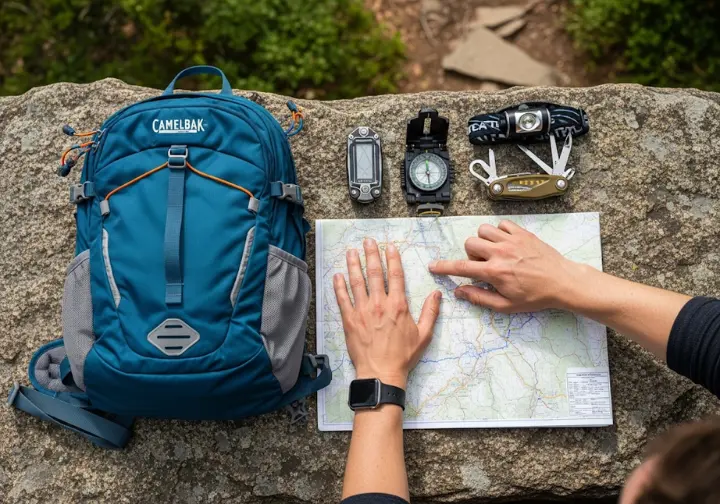
To make a smart, confident choice, you need objective knowledge. This section is designed to arm you with that knowledge, transforming you from a passive consumer into an informed analyst of your own gear needs and showing you how to choose a hydration pack that’s perfect for you.
Why Do Pack Capacity and Reservoir Size Matter for My Hike?
Thinking about a pack’s capacity (liters / cubic inches) requires you to consider two distinct but related metrics: Gear Volume and Hydration Volume. Gear Volume dictates how much equipment you can carry, from extra layers and food to a first-aid kit. A smaller hydration pack in the 10 to 20-liter range is often ideal for a short day-hike, while longer excursions into variable conditions or higher altitudes demand the 21-liter-plus tier to safely accommodate more gear. Hydration Volume refers to the hydration reservoir size. This is where a strategic water-to-weight trade-off comes into play. Since one liter of water adds about 2.2 pounds to your load, water budgeting by mileage/heat is crucial. However, opting for a pack with a larger CamelBak Crux 3L reservoir provides incredible versatility; you can simply under-fill it for shorter hikes, giving you maximum flexibility for a minimal weight penalty when empty. This reframes the choice from “how much can I carry?” to the much more important question: “what do I need to carry for this specific mission’s safety and comfort?” The answer starts with matching your gear capacity to the Ten Essentials system.
To make this tangible, we developed a Trail Difficulty Matrix as a guiding principle. This framework helps you estimate your needs based on the objective demands of your hike. For an ‘Easy’ trail under 5 miles with minimal elevation, a 1.5L-2L reservoir is often sufficient. For a ‘Moderate’ 5-10 mile hike, a 2.5L reservoir is a safer bet. Once you move into ‘Hard’ (10-15 miles) or ‘Strenuous’ (15+ miles with significant elevation, approaching an alpine scramble), a 3L reservoir becomes essential to ensure you have adequate water between potential refill sources, dictating your refill-interval guidance. The answer to “how much water do I need per mile” depends heavily on temperature range and exertion, but this matrix provides a solid starting point.
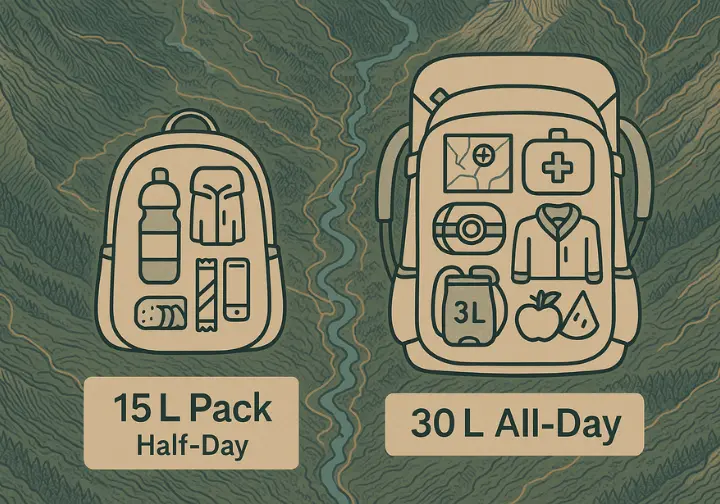
But carrying the right amount of gear is useless if the pack itself causes pain; that’s why proper fit is the most important factor of all.
How Does Pack Fit and Ergonomics Prevent Fatigue?
The foundation of a comfortable pack isn’t its features; it’s how it fits your unique body. The single most critical measurement for this is your Torso Length. This isn’t your height, but the specific distance from your C7 vertebra—the bony bump at the base of your neck—down to the top of your iliac crest, which is the shelf of your hip bones. A pack that matches your torso length and offers torso length adjustability will correctly transfer the majority of its weight onto your hips, the strongest part of your body, preventing shoulder and back fatigue.
This weight transfer is accomplished by the hipbelt, which may include valuable hip-belt pockets for small items. A simple webbing hipbelt primarily offers stability, keeping the pack from swinging around. In contrast, a padded, load-bearing hipbelt with load-lifters is engineered to wrap securely around your iliac crest and bear the load. Working in concert with the hipbelt is the Sternum Strap, which connects the shoulder straps across your chest, dramatically enhancing stability on technical or uneven terrain. Furthermore, a Women’s-Specific Fit is a true performance feature, not just an aesthetic one. It incorporates S-curve straps that arc away from the chest, shorter torso length options, and hipbelts that are canted at an angle to sit more naturally on the female pelvis, eliminating gaps and pressure points.
Pro-Tip: When trying on a pack, load it with about 15-20 pounds. First, loosen all the straps. Position the hipbelt so the padding sits directly on top of your hip bones (iliac crest) and tighten it snugly. Then, tighten the shoulder straps. There should be no gap between the top of your shoulders and the straps. If there is, the torso length is too long.
Once the pack is fitted correctly to your body, the next step is ensuring it manages heat and sweat effectively against your back.
What’s the Difference Between CamelBak’s Back Panels?
A pack’s suspension system has to perform a difficult balancing act: it must carry the load stably while also providing enough ventilation to keep you from overheating. The design philosophy behind a ventilated back-panel often depends on the intended activity. A design that sits closer to the back provides maximum stability, which is favored for dynamic activities like scrambling or mountain biking. Conversely, a ventilated mesh back-panel that creates a large air gap offers maximum airflow and a high breathability index, making it ideal for hiking in desert heat.
CamelBak has engineered a spectrum of proprietary systems to address this. The Air Director back-panel uses strategically placed foam pods that create air channels against your back, offering a great balance of stability and moderate airflow. For more demanding conditions, the Air Support back-panel and Air Support™ Max systems use advanced body-mapping to increase ventilation where you need it most. The pinnacle of this technology is the “Max” version, which is a full tensioned-mesh suspension. It holds the main body of the pack completely off your back, creating a chimney of airflow for the highest level of cooling on the hottest days.
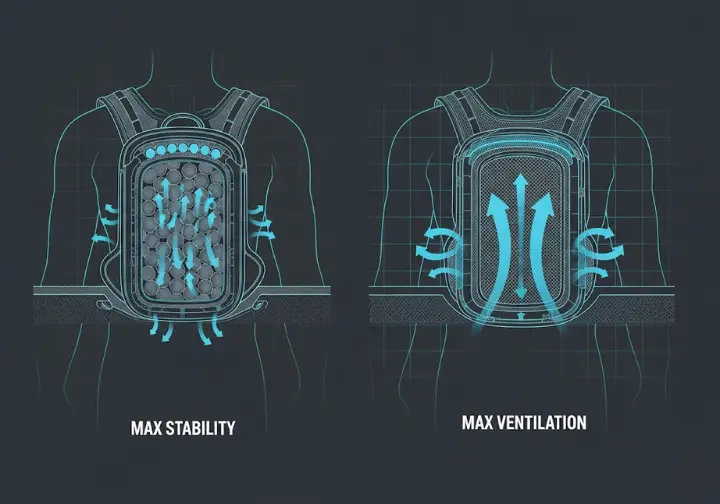
While the back panel keeps you cool, the integrated hydration system is what keeps you performing at your peak.
Which Hydration System Features Actually Make a Difference?
The modern CamelBak ecosystem consists of three core components: the Reservoir, the Bite Valve, and the Tube. The workhorse is the BPA/BPS/BPF-free Crux® Reservoir, celebrated for its high flow rate that delivers more water per sip and an ergonomic handle that makes refilling less of a chore. At the end of the tube, the classic CamelBak Big Bite Valve allows for easy, hands-free drinking.
Beyond these basics, several convenience features have a real impact on usability and safety. An On/Off Lever at the base of the bite valve is a critical feature that prevents leaks during transport—no one wants to arrive at the trailhead with a soaked pack. The Magnetic Tube Trap is a brilliant little innovation that keeps the drinking hose secure on your shoulder strap, making it instantly accessible when you need it and preventing it from snagging on branches. Finally, the Quick-Link System, with its auto-shut-off valve, allows you to disconnect the tube from the base of the reservoir. This means you can easily pull the reservoir out for refilling without having to unthread the entire hose from your pack’s shoulder straps, a small detail that saves a surprising amount of time and hassle. Many of these reservoirs also boast excellent compatibility with filtration systems like the Katadyn BeFree or Sawyer filters. When you’re ready to dial in your choice, it’s about moving beyond individual features and applying them to a real-world planning framework, like the one provided by the National Park Service for determining hiking difficulty. This helps in choosing the right hiking drinking bottle or reservoir for any given challenge.
Pro-Tip: In freezing temperatures, your hydration tube is the first thing to freeze. After taking a drink, blow air back into the tube until you hear a bubbling sound in the reservoir. This clears the tube of water, dramatically reducing the chance of it freezing solid.
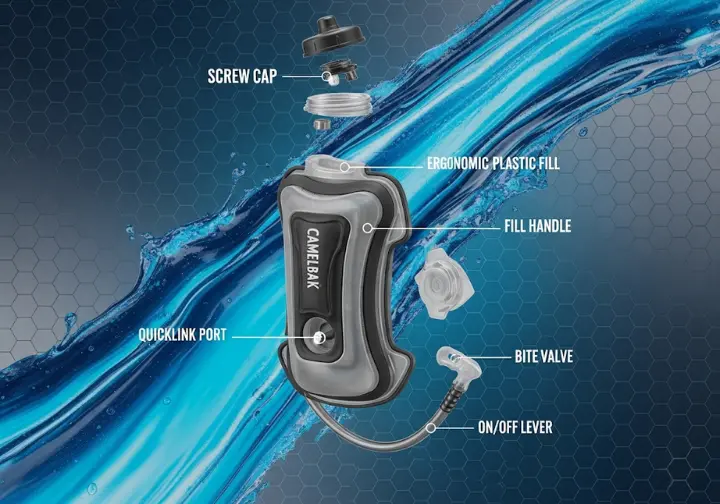
To truly dial in your choice, we need to move beyond individual features and apply them to a real-world planning framework.
Our Selection Process: How We Built This Guide
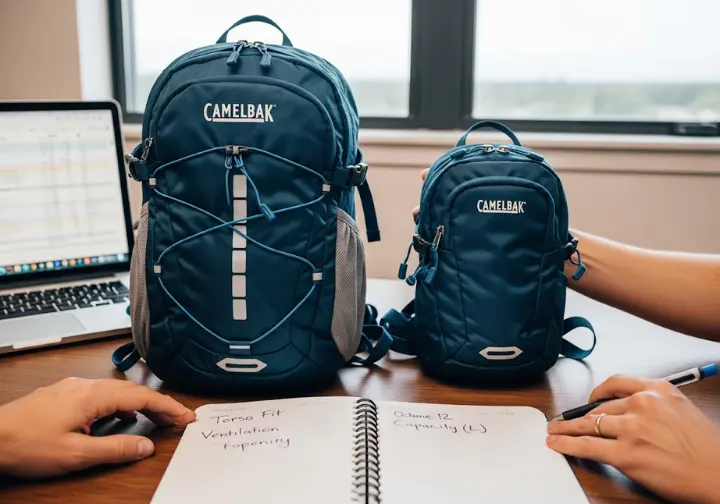
Our goal here is absolute trust. We want to transparently detail our rigorous research and curation process, showing you that our recommendations are earned, not arbitrary.
Our Commitment to Objectivity: Our primary goal is to empower you with expert knowledge. The recommendations you see here are the final step in an educational journey, not the starting point. We believe an informed hiker is a safe and happy hiker, and our content is structured to build your expertise first.
The Evaluation Framework: We began this process by deconstructing the modern hydration pack into its most critical attributes: load-carrying comfort, ventilation efficiency, durability, organizational layout, and hydration system usability. Every product considered for this guide was judged against this objective framework, focusing on performance, price-to-performance, and real-world user benefits, not just marketing claims.
How We Selected the Products: Our selection was a two-phase process. First, we synthesized performance data from dozens of expert reviews, side-by-side lab testing reports, and thousands of real-world user reports to identify the top-performing models in the market. Second, we took that shortlist and mapped each product to a distinct hiker archetype and their specific mission profile, ensuring every pack we recommend solves a real problem for a real hiker.
A Note on Affiliate Links: If you choose to make a purchase through the links in this article, we may earn a small commission at no extra cost to you. This helps support our work and allows us to keep creating in-depth, independent gear guides. Rest assured, our recommendations are always driven by our research and our commitment to your needs.
The Best Camelback Backpacks of 2025: Our Top Recommendations for Every Need
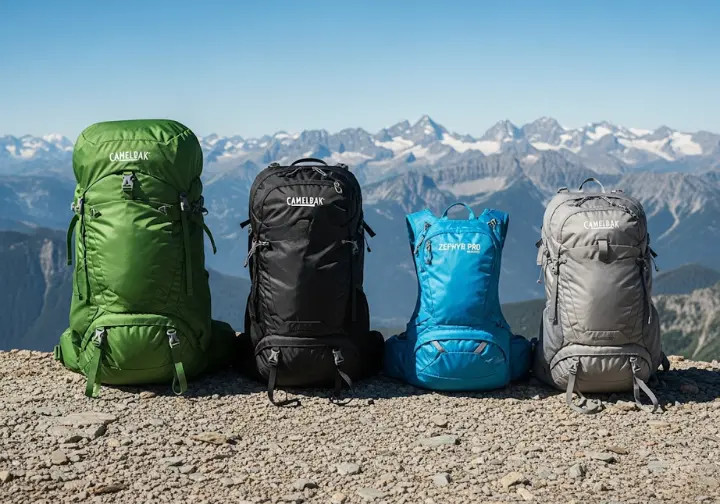
Now that you’re armed with the framework, it’s time to see it in action. Here are our curated top recommendations, providing a clear “best for you” choice based on the knowledge you’ve gained.
Our Top Picks for The All-Day Adventurer
This hiker is tackling long, strenuous day hikes, often in variable mountain conditions. They need one of the best hydration packs available, prioritizing capacity for extra layers and safety gear, supreme comfort for long hours on the trail, and best-in-class ventilation to manage heat during strenuous ascents. This is often where the M.U.L.E. vs Fourteener debate comes into play, with the Fourteener line excelling at pure hiking comfort.
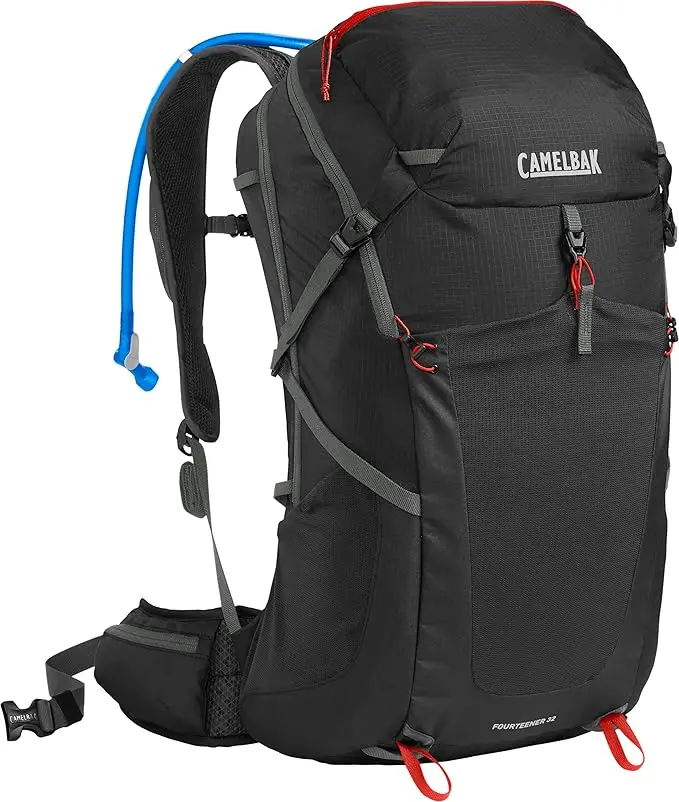
The CamelBak Fourteener 32 is the definitive choice for ambitious, all-day objectives where carrying capacity for extra layers, safety gear, and ample water is non-negotiable. Its robust 32L gear capacity and included CamelBak Crux 3L reservoir are matched with the premier Air Support™ Max tension-mesh suspension, which provides a cooling chimney of air between you and the pack. The padded, load-bearing hipbelt and dedicated trekking pole loops round out a package that masterfully solves the problem of managing sweat and heat on long climbs while comfortably carrying a full load for over eight hours. Its robust construction, with a high fabric denier and DWR coating, adds some base weight, but for big missions, the trade-off is well worth it.
PROS
- Exceptional Air Support™ Max ventilation
- Comfortable load-bearing hipbelt
- Ample 32L gear and 3L water capacity
CONS
- Heavier base weight due to robust build
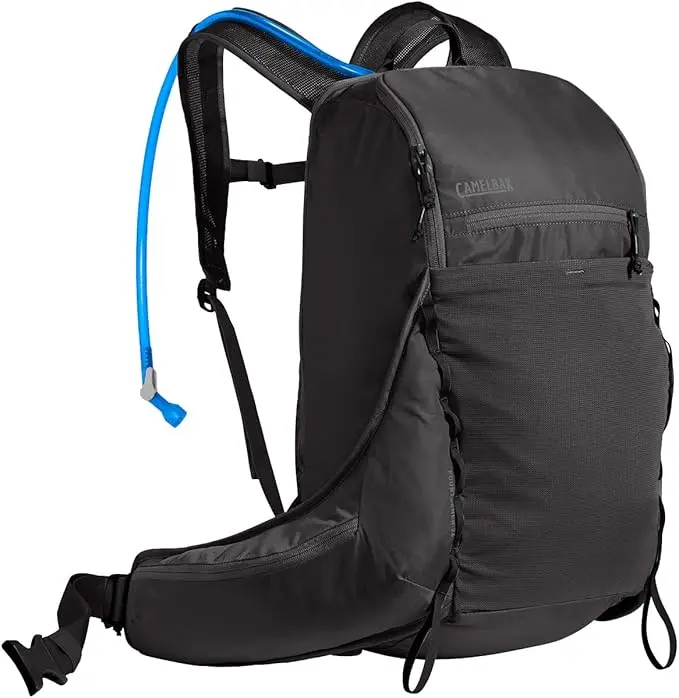
For adventurers who demand the same top-tier ventilation and stable suspension as its larger sibling but in a more streamlined package, the Fourteener 26 is the answer. It features the same elite Air Support™ Max cooling system and a padded hipbelt for excellent load transfer, all built around a more compact 26L gear capacity. It still includes a full 3L reservoir, making it perfect for the hiker on hot summer days who prioritizes maximum comfort and hydration security without the bulk of a 30L+ pack. Some reviews note a desire for more external zippered pockets, but its on-trail comfort is undeniable.
PROS
- Elite Air Support™ Max cooling system
- Streamlined size with full 3L reservoir
- Available in women’s-specific models
CONS
- Pocket layout lacks external zippered options
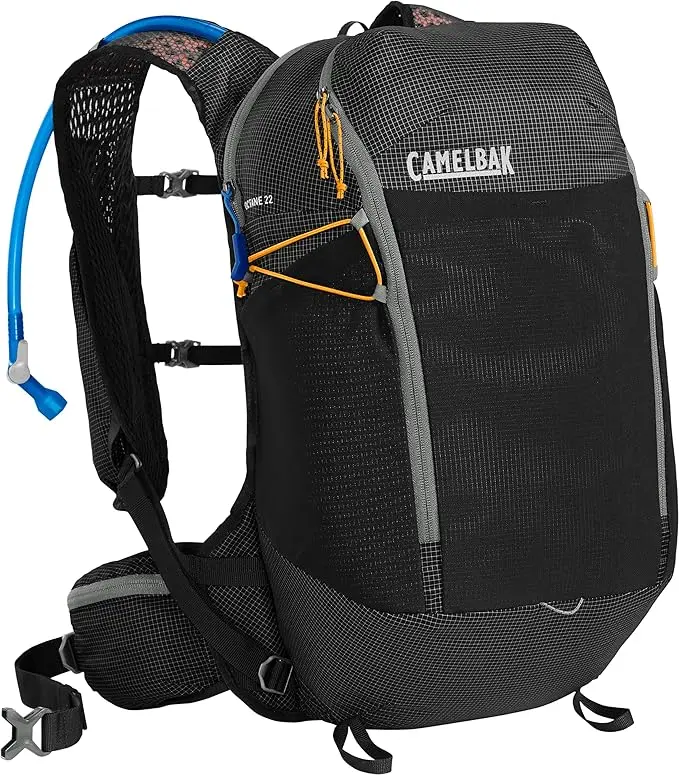
The CamelBak Octane 22 is a unique hybrid pack for the adventurer who moves fast and values on-the-go accessibility above all else. It merges the capacity of a daypack with the fit of a trail running vest, featuring a “Command Center” running vest-style harness with dual sternum straps and multiple front-facing pockets for flasks and nutrition. With 20L of gear space and a 2L Fusion reservoir, it solves the need for more-than-a-vest capacity on fast-and-light all-day missions, completely eliminating the need to stop to access fuel or gear. While heavier than a pure running vest, its bounce-free fit is exceptional for its size, though the one-size design may not suit all body types.
PROS
- Secure, bounce-free vest-style harness
- Excellent on-the-go front pocket access
- Great for fast-and-light hybrid missions
CONS
- Heavier than a pure running vest
- One-size design may not fit everyone
Our Top Picks for The Fast & Light Minimalist
This user is a trail-running enthusiast or speed hiker who lives by the mantra “efficiency is speed.” They prioritize ultralight hydration, minimal weight, and a secure, bounce-free fit to hydrate and refuel without breaking stride.
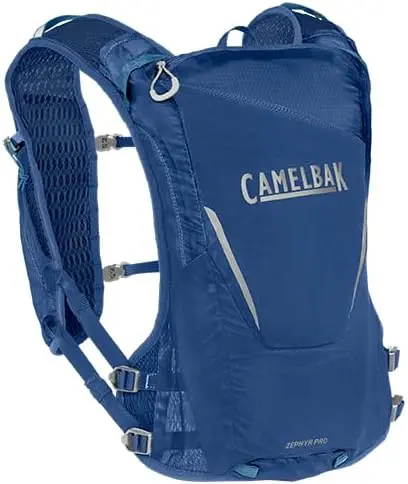
The CamelBak Zephyr Pro Vest is a high-performance running vest engineered for maximum speed and minimal weight. It’s designed to be a second skin, using an engineered knit mesh that offers extreme breathability while hugging the body to eliminate bounce entirely. Instead of a single reservoir, it carries two 0.5L CamelBak Quick Stow Flask units in the front harness pockets, allowing for immediate access to fuel and hydration without breaking stride. The 11L of gear capacity and a removable trekking pole quiver solve the two biggest needs of a competitive trail runner. The rear compartment is too small for extensive mountain safety gear, but for pure performance on long runs, it’s unmatched.
PROS
- Body-hugging fit eliminates bounce
- Extreme breathability from knit mesh
- Instant access to fuel and soft flasks
CONS
- Not enough capacity for big mountain days
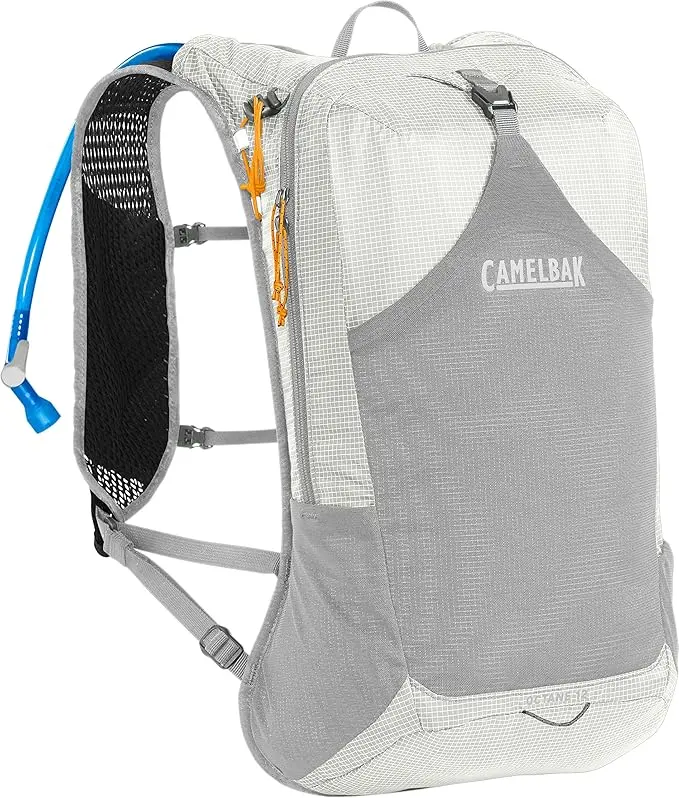
For the user who finds a pure running vest too minimal for safety gear but a daypack too bulky for speed, the Octane 12 strikes the ideal balance. It offers 10L of gear capacity with a 2L Fusion reservoir, all integrated into a vest-style harness with front storage and dual sternum straps. The 3D Vent Mesh back panel ensures high breathability. It perfectly solves the need for carrying that crucial extra layer and a water filter on long trail runs or fast hikes of 2-4 hours, where a vest’s capacity just falls short. Its one-size design is a potential fit issue for some, but for many, it’s the perfect fast-and-light solution.
PROS
- Balances vest fit with daypack capacity
- Highly breathable 3D Vent Mesh back
- Ideal for 2-4 hour fast hikes or runs
CONS
- One-size design can be a fit issue
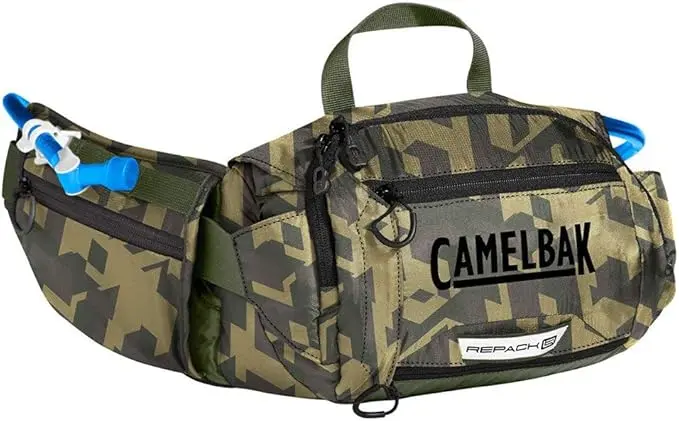
The CamelBak Repack LR 4 is a specialized hip pack that offers the ultimate in minimalist freedom for bike enduro or fast hiking. By shifting 2.5L of gear and a 1.5L lumbar reservoir to the hips, it uses a low-rider fit to lower your center of gravity and leave your entire back free for maximum ventilation. An integrated compression system cinches the pack down as the reservoir empties, maintaining stability on the move. It’s the perfect solution for the minimalist who wants to eliminate a backpack entirely for short, fast missions where only water and a few essentials are needed. While its capacity is limited, for those who prize a free back and shoulders above all else, the Repack is liberating.
PROS
- Ultimate freedom and back ventilation
- Low Rider (LR) design lowers gravity center
- Compression straps maintain stability
CONS
- Very limited gear capacity
- Magnetic tube clip can be insecure
Our Top Picks for The Gear-Intensive Specialist
This is the multi-sport user, the technical hiker, or the mountain biker who values meticulous organization, best in class durability, and specific external attachment points to carry their tools of the trade, whether that’s for a mountain-bike crossover adventure or a winter ascent.
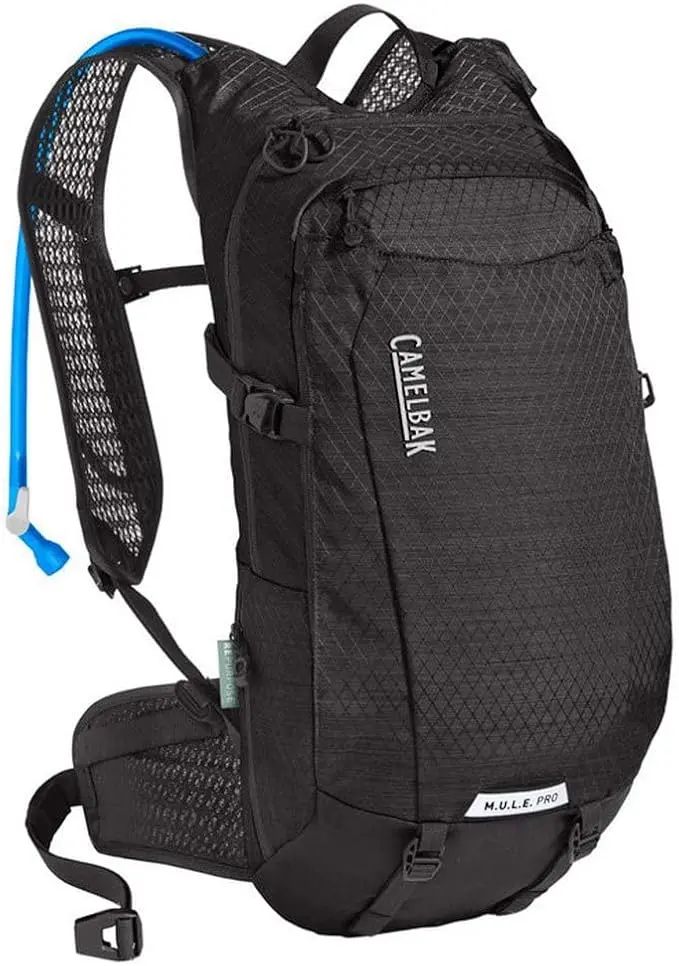
The CamelBak M.U.L.E. Pro 14 is the archetypal multi-sport hydration pack, and the Pro 14 version elevates it with premium ventilation and organization. Designed for technical mountain biking but equally at home on a technical hike, it combines 11L of gear space with a 3L reservoir. Its genius lies in its features: an integrated tool roll, external helmet carry straps, and compatibility with an impact protector. The Air Support™ Pro back panel and 3D Vent Mesh harness solve the problem of keeping tools and gear meticulously organized and accessible during dynamic, high-exertion activities. Many of its fabrics are recycled nylon, showcasing a commitment to sustainability.
PROS
- Excellent organization with tool roll
- Air Support™ Pro panel for ventilation
- Specific features for helmet/impact gear
CONS
- Standard M.U.L.E. has poor ventilation
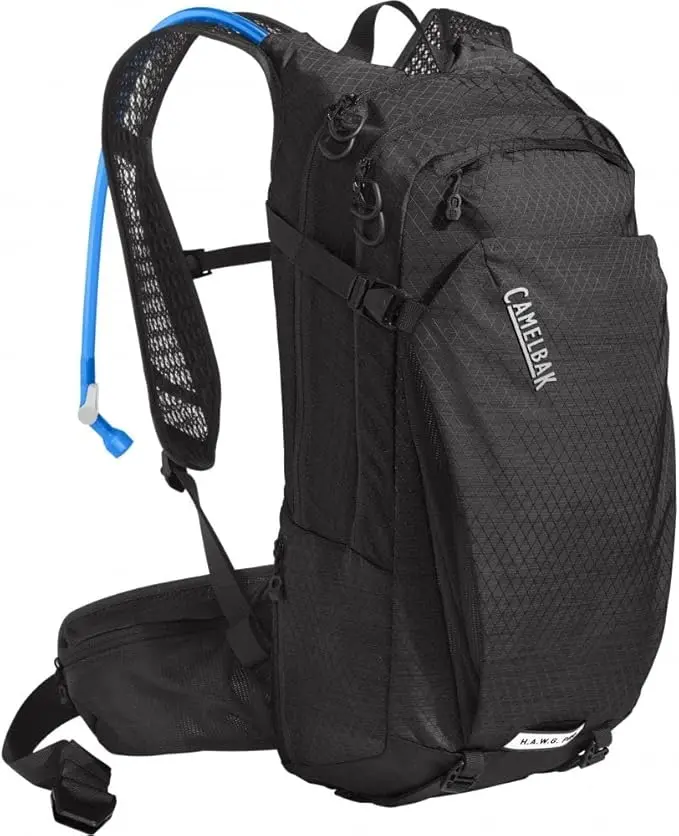
For epic, gear-intensive days, the CamelBak H.A.W.G. Pro 20 is the workhorse. It’s designed to carry more than the M.U.L.E. can handle, with 17L of gear capacity and a 3L reservoir. Its specialist features include extensive internal organization, helmet carry, and even a dedicated padded sleeve designed to securely hold an e-bike battery. The Air Support™ Pro back panel and padded hipbelt ensure that even a heavy load remains stable and comfortable. It’s the perfect solution for the specialist who needs to haul extra equipment without sacrificing organization or stability. It is heavier than hiking-specific packs and lacks torso-length adjustment, but its feature set is unmatched for its purpose.
PROS
- Massive capacity for gear and e-bike battery
- Superior organization and stability
- Pro-level ventilation and padded hipbelt
CONS
- Heavier than hiking-specific packs
- Lacks torso length adjustment
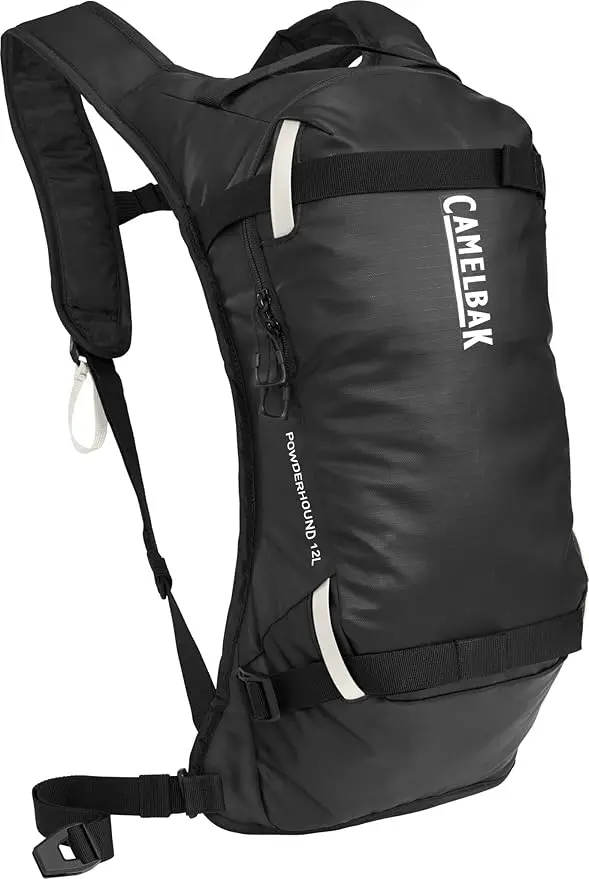
The CamelBak Powderhound 12 is a specialized pack engineered for a single, critical purpose: to protect your water supply from freezing during winter sports, a perfect example of smart cold weather hacks. It tackles this with an insulated tube and reservoir sleeve providing excellent winter insulation. The “Snowshed” back panel is made from material designed to prevent snow from sticking and melting. With 9L of gear space, a 3L reservoir, and straps for a ski-carry diagonal or vertical snowboard carry, it directly solves the critical failure point of standard hydration systems in sub-zero temperatures. Some models even feature dedicated sleeves for an avalanche shovel and probe.
PROS
- Insulated tube/sleeve prevents freezing
- “Snowshed” back panel repels snow
- Straps for ski or snowboard carry
CONS
- Limited utility outside of winter
- Specialized features add weight
Our Top Picks for The Trail-Ready Novice
This is the new hiker or the person who prefers shorter, less demanding trails. They don’t need expedition-level features, but they do need a reliable, user-friendly, and comfortable pack that delivers exceptional value, often as a budget pick.

The CamelBak Rim Runner 22 is the perfect first “serious” hydration pack, offering an exceptional balance of capacity, comfort, organization, and value. With 19.5L of gear space and a 2.5L CamelBak Crux 2L reservoir, it’s sized perfectly for most day hikes. What sets it apart at its price point is a surprisingly supportive padded hipbelt and an excellent pocket layout for easy organization. It provides the core features of a more advanced pack, making longer hikes comfortable and helping a novice build confidence. While the back panel lacks the advanced ventilation of premium models, its overall performance and durability make it an outstanding investment.
PROS
- Excellent balance of features and value
- Supportive padded hipbelt for its class
- Great organization for a novice hiker
CONS
- Back panel lacks advanced ventilation
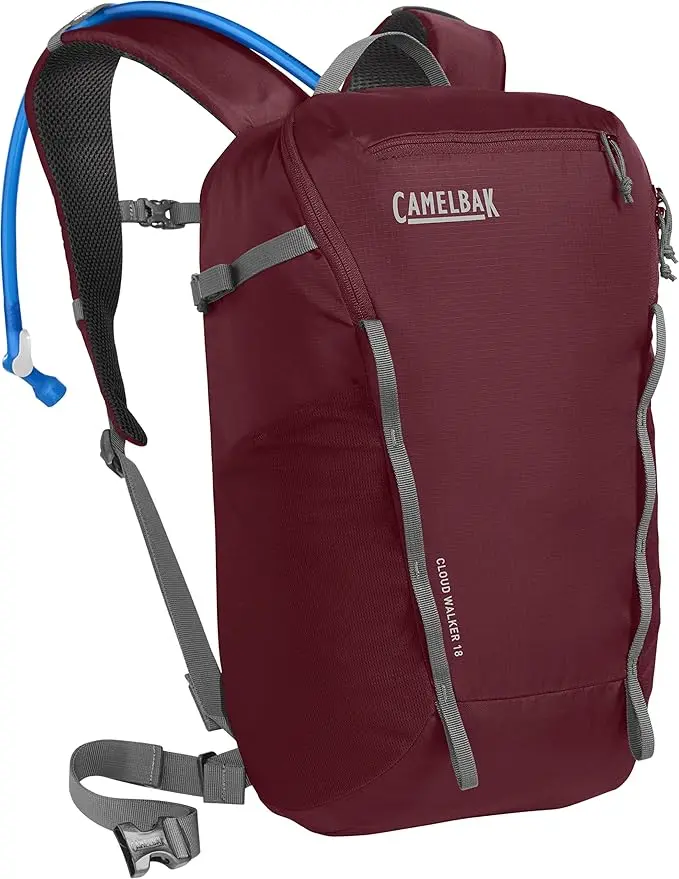
The CamelBak Cloud Walker 18 is a simple, reliable, and highly versatile pack that is equally at home on an easy trail as it is on a college campus, making it a true commuter/hike hybrid. It offers a straightforward design with a large main compartment, 15.5L of gear capacity, and daisy chain attachments for lashing extra items. Despite its accessible price, it includes the same premium 2.5L Crux hydration system found in more expensive packs. It’s a no-frills, dependable solution for casual use, providing excellent hydration performance without overwhelming a beginner with complex features. The lack of a structured hipbelt means all weight is on the shoulders, making it best for lighter loads.
PROS
- Simple, reliable, and highly versatile
- Includes premium 2.5L Crux reservoir
- Great value for casual trail and town use
CONS
- No hipbelt; all weight on shoulders
- Can be unstable with heavier loads
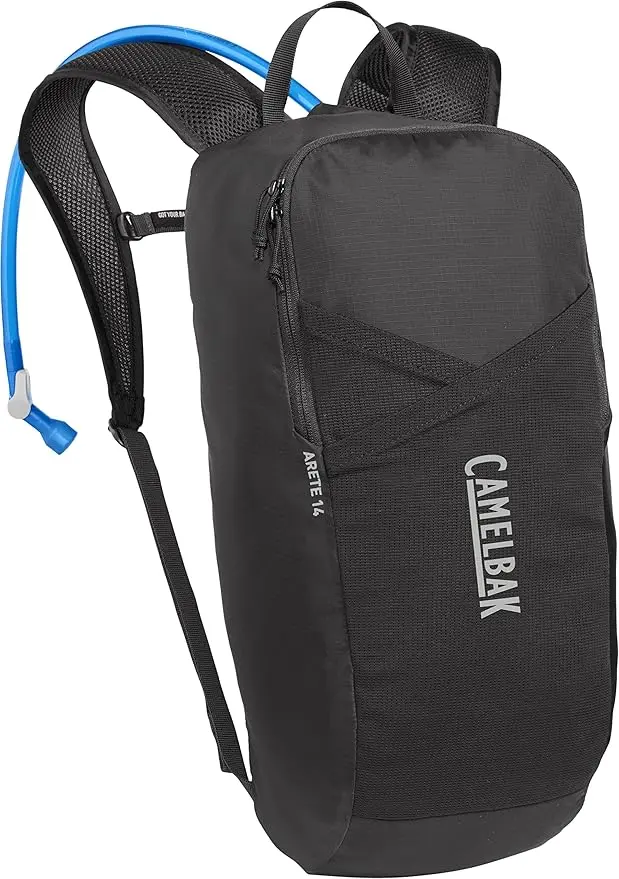
For short, simple hikes where only the absolute essentials are needed, the Arete 14 is an extremely lightweight, minimalist, and affordable option. Weighing a mere 10.5 oz (weight (oz / g)), it provides 14L of gear space and a 1.5L Crux reservoir in the most streamlined package possible. Its simple pocketing with stretch-mesh pockets and a breathable air mesh back panel make it the ideal “grab-and-go” pack for quick outings. It delivers reliable hydration at the lowest possible weight and price. The minimalist, frameless design offers no structured support, making it unsuitable for heavy loads, but for its intended purpose, it’s brilliant.
PROS
- Extremely lightweight at only 10.5 oz
- Ideal “grab-and-go” minimalist pack
- Very affordable price point
CONS
- No frame or structured support
Conclusion
Your journey to finding the perfect pack is now grounded in a solid framework. Remember that fit comes before features; always prioritize a pack with the correct torso length and a supportive hipbelt as the foundation of comfort. Use our guide to match the pack’s capacity to your mission, ensuring you have enough volume for safety essentials but not so much that you’re tempted to overpack. Understand that ventilation is a safety feature; a breathable back panel like Air Support™ Max prevents chilling by managing moisture. And finally, recognize that convenience drives hydration; features like the Quick Link™ system encourage you to drink more, which is the key to preventing dehydration.
Armed with this knowledge, you’re ready to choose the best CamelBak backpack for hiking. Review our top picks for your hiker type and invest in the comfort, safety, and performance, backed by the Got Your Bak lifetime warranty, that will fuel your adventures for years to come.
Frequently Asked Questions about Choosing a CamelBak Backpack
What is the single most important factor when choosing a hiking pack?
The single most important factor is a proper fit, which is determined by your specific torso length, not your overall height. A pack that is too long or too short for your torso will place the weight on your shoulders instead of your hips, leading to fatigue and pain. A pack like the CamelBak Fourteener 26, with its robust suspension and defined torso fit range, is specifically designed to transfer weight correctly to the hips, making it comfortable for long hours on the trail.
How do I clean my CamelBak reservoir?
Learning how to clean a CamelBak bladder is essential for post-purchase care. The best method for ensuring cleaning and drying ease is to ensure all parts can dry completely to prevent mold. First, disassemble the reservoir, hose, and bite valve. Use a specialized CamelBak Cleaning Kit, which includes a reservoir brush and tube brush, with mild soap and warm water. Scrub the inside of the reservoir and the full length of the tube. Rinse all parts thoroughly and then hang them to air dry completely before reassembling for storage.
Is a 3L reservoir too big for a short day hike?
No, a 3L reservoir is incredibly versatile and often a smarter choice even for shorter hikes. The key benefit is flexibility. You can simply under-fill it with 1 or 2 liters of water for a short outing, and the weight penalty of the slightly larger empty reservoir is minimal. This means you own one reservoir that is ready for any adventure. Models like the CamelBak M.U.L.E. Pro 14 come standard with a 3L reservoir for this very reason.
What makes a women’s-specific fit different?
A true women’s-specific fit is an ergonomic engineering solution, not just a different color. It typically involves three key design changes. First, the shoulder straps are S-curved to arc around the chest, eliminating pressure points. Second, the available torso lengths are generally shorter to accommodate the different average proportions between men and women. Finally, the hipbelts are often canted at a slightly different angle to sit more comfortably and securely on female hips. The CamelBak Women’s L.U.X.E. 14, the counterpart to the M.U.L.E., is a prime example of this thoughtful, performance-oriented design.
Risk Disclaimer: Hiking, trekking, backpacking, and all related outdoor activities involve inherent risks which may result in serious injury, illness, or death. The information provided on The Hiking Tribe is for educational and informational purposes only. While we strive for accuracy, information on trails, gear, techniques, and safety is not a substitute for your own best judgment and thorough preparation. Trail conditions, weather, and other environmental factors change rapidly and may differ from what is described on this site. Always check with official sources like park services for the most current alerts and conditions. Never undertake a hike beyond your abilities and always be prepared for the unexpected. By using this website, you agree that you are solely responsible for your own safety. Any reliance you place on our content is strictly at your own risk, and you assume all liability for your actions and decisions in the outdoors. The Hiking Tribe and its authors will not be held liable for any injury, damage, or loss sustained in connection with the use of the information herein.
Affiliate Disclosure: We are a participant in the Amazon Services LLC Associates Program, an affiliate advertising program designed to provide a means for us to earn advertising fees by advertising and linking to Amazon.com. As an Amazon Associate, we earn from qualifying purchases. We also participate in other affiliate programs and may receive a commission on products purchased through our links, at no extra cost to you. Additional terms are found in the terms of service.



